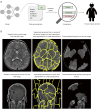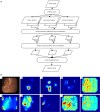A literature review of artificial intelligence (AI) for medical image segmentation: from AI and explainable AI to trustworthy AI
- PMID: 39698664
- PMCID: PMC11651983
- DOI: 10.21037/qims-24-723
A literature review of artificial intelligence (AI) for medical image segmentation: from AI and explainable AI to trustworthy AI
Abstract
Background and objective: Medical image segmentation is a vital aspect of medical image processing, allowing healthcare professionals to conduct precise and comprehensive lesion analyses. Traditional segmentation methods are often labor intensive and influenced by the subjectivity of individual physicians. The advent of artificial intelligence (AI) has transformed this field by reducing the workload of physicians, and improving the accuracy and efficiency of disease diagnosis. However, conventional AI techniques are not without challenges. Issues such as inexplicability, uncontrollable decision-making processes, and unpredictability can lead to confusion and uncertainty in clinical decision-making. This review explores the evolution of AI in medical image segmentation, focusing on the development and impact of explainable AI (XAI) and trustworthy AI (TAI).
Methods: This review synthesizes existing literature on traditional segmentation methods, AI-based approaches, and the transition from conventional AI to XAI and TAI. The review highlights the key principles and advancements in XAI that aim to address the shortcomings of conventional AI by enhancing transparency and interpretability. It further examines how TAI builds on XAI to improve the reliability, safety, and accountability of AI systems in medical image segmentation.
Key content and findings: XAI has emerged as a solution to the limitations of conventional AI by providing greater transparency and interpretability, allowing healthcare professionals to better understand and trust AI-driven decisions. However, XAI itself faces challenges, including those related to safety, robustness, and value alignment. TAI has been developed to overcome these challenges, offering a more reliable framework for AI applications in medical image segmentation. By integrating the principles of XAI with enhanced safety and dependability, TAI addresses the critical need for TAI systems in clinical settings.
Conclusions: TAI presents a promising future for medical image segmentation, combining the benefits of AI with improved reliability and safety. Thus, TAI is a more viable and dependable option for healthcare applications, and could ultimately lead to better clinical outcomes for patients, and advance the field of medical image processing.
Keywords: Medical image segmentation; artificial intelligence (AI); explainable AI (XAI); trustworthy AI (TAI).
2024 AME Publishing Company. All rights reserved.
Conflict of interest statement
Conflicts of Interest: All authors have completed the ICMJE uniform disclosure form (available at https://qims.amegroups.com/article/view/10.21037/qims-24-723/coif). The authors have no conflicts of interest to declare.
Figures














Similar articles
-
Unveiling the black box: A systematic review of Explainable Artificial Intelligence in medical image analysis.Comput Struct Biotechnol J. 2024 Aug 12;24:542-560. doi: 10.1016/j.csbj.2024.08.005. eCollection 2024 Dec. Comput Struct Biotechnol J. 2024. PMID: 39252818 Free PMC article. Review.
-
How Explainable Artificial Intelligence Can Increase or Decrease Clinicians' Trust in AI Applications in Health Care: Systematic Review.JMIR AI. 2024 Oct 30;3:e53207. doi: 10.2196/53207. JMIR AI. 2024. PMID: 39476365 Free PMC article. Review.
-
A review of explainable AI techniques and their evaluation in mammography for breast cancer screening.Clin Imaging. 2025 Jul;123:110492. doi: 10.1016/j.clinimag.2025.110492. Epub 2025 May 12. Clin Imaging. 2025. PMID: 40378639 Review.
-
The role of explainable artificial intelligence in disease prediction: a systematic literature review and future research directions.BMC Med Inform Decis Mak. 2025 Mar 4;25(1):110. doi: 10.1186/s12911-025-02944-6. BMC Med Inform Decis Mak. 2025. PMID: 40038704 Free PMC article.
-
Artificial intelligence in hospital infection prevention: an integrative review.Front Public Health. 2025 Apr 2;13:1547450. doi: 10.3389/fpubh.2025.1547450. eCollection 2025. Front Public Health. 2025. PMID: 40241963 Free PMC article. Review.
Cited by
-
Bibliometric analysis of the application of artificial intelligence in orthopedic imaging.Quant Imaging Med Surg. 2025 May 1;15(5):3993-4013. doi: 10.21037/qims-24-1384. Epub 2025 Apr 28. Quant Imaging Med Surg. 2025. PMID: 40384704 Free PMC article.
-
Histological Image Classification Between Follicular Lymphoma and Reactive Lymphoid Tissue Using Deep Learning and Explainable Artificial Intelligence (XAI).Cancers (Basel). 2025 Jul 22;17(15):2428. doi: 10.3390/cancers17152428. Cancers (Basel). 2025. PMID: 40805131 Free PMC article.
-
Machine Learning Based Early Diagnosis of ADHD with SHAP Value Interpretation: A Retrospective Observational Study.Neuropsychiatr Dis Treat. 2025 May 21;21:1075-1090. doi: 10.2147/NDT.S519492. eCollection 2025. Neuropsychiatr Dis Treat. 2025. PMID: 40417187 Free PMC article.
-
Artificial intelligence-assisted analysis of musculoskeletal imaging-A narrative review of the current state of machine learning models.Knee Surg Sports Traumatol Arthrosc. 2025 Aug;33(8):3032-3038. doi: 10.1002/ksa.12702. Epub 2025 Jun 1. Knee Surg Sports Traumatol Arthrosc. 2025. PMID: 40450562 Free PMC article. Review.
-
Advanced skin cancer prediction with medical image data using MobileNetV2 deep learning and optimized techniques.Sci Rep. 2025 Aug 7;15(1):28962. doi: 10.1038/s41598-025-14963-4. Sci Rep. 2025. PMID: 40775513 Free PMC article.
References
-
- Lee LK, Liew SC, Thong WJ. A review of image segmentation methodologies in medical image. Adv Comput Commun Eng Technol 2015;1069-80.
-
- Chen A, Zhu L, Zang H, Ding Z, Zhan S. Computer-aided diagnosis and decision-making system for medical data analysis: a case study on prostate MR images. J Manag Sci Eng 2019;4:266-78.
-
- Abdel-Basset M, Chang V, Mohamed R. A novel equilibrium optimization algorithm for multi-thresholding image segmentation problems. Neural Comput Appl 2021;33:10685-718.
-
- Yang D, Xu Z, Li W, Myronenko A, Roth HR, Harmon S, Xu S, Turkbey B, Turkbey E, Wang X, Zhu W, Carrafiello G, Patella F, Cariati M, Obinata H, Mori H, Tamura K, An P, Wood BJ, Xu D. Federated semi-supervised learning for COVID region segmentation in chest CT using multi-national data from China, Italy, Japan. Med Image Anal 2021;70:101992. 10.1016/j.media.2021.101992 - DOI - PMC - PubMed
Publication types
LinkOut - more resources
Full Text Sources
